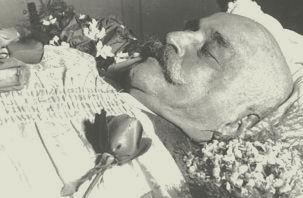G.I. Gurdjieff
Gurdjieff's Final Years
At war's end, despite increasing infirmity due to age and illness, he visited America. During his final years, Gurdjieff called his many students to him so that he might instill in them again the essential experience of the source of The Fourth Way.
In late August 1949, dying of cancer, Gurdjieff insisted on making a 350 mile journey to the South of France to see the caves of Lascaux. He believed it to be the center of an ancient brotherhood. A brotherhood to whom the emblem of the cave's Great Stag was unique. Read "Gurdjieff at Lascaux."

Gurdjieff died the morning of October 29, 1949. William Welch, his American doctor, said, "I have seen many men die. He died like a king."
As Gurdjieff directed, the funeral service took place in the Russian Orthodox Church in the rue Daru. The priest read the eulogy prepared by Thomas de Hartmann. It was written in such a way that the last words pronounced by the priest in front of Gurdjieff's coffin are from Gurdjieff's ballet The Struggle of the Magicians: "Lord Creator and all you His assistants, help us to be able to remember ourselves at all times in order that we may avoid involuntary actions, as only through them can evil manifest itself." Gurdjieff was then buried at Avon Cemetery at Fontainebleau, not far from the Prieuré.
The Struggle of the Magicians was Gurdjieff's ballet but it is more like a symbolic play with movements and music. He said that the dances were based on movements and gestures handed down by tradition and paintings in Tibetan monasteries. He never spoke about the origin of the music. The setting is a densely populated Oriental town where Gaffar, a rich and hedonistic noble, falls in love with the beautiful Zeinab, the student of a White Magician whose students study the cosmoses and whose symbol is the enneagram.
Gafar enlists a Black Magician to win Zeinab's heart. The Black Magician casts a spell on her. The White Magician magically destroys his rival and brings Gafar and Zeinab to him. They both arrive like zombies.
Awakened by the White Magician, they reconcile with a final benediction from the White Magician and a prayer to the Creator to help men to avoid involuntary actions. The scenario was published by the Stourton Press, Capetown, South Africa, in 1957.